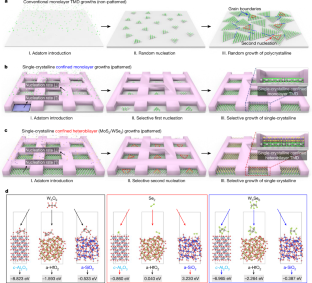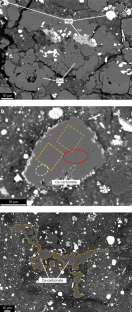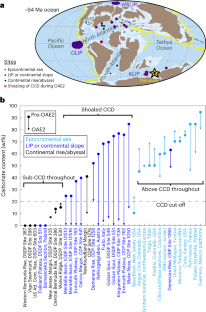Sang-Hoon Bae氏と共同研究者は、次世代エレクトロニクスをより速く、より少ない電力で実現するための研究を行った。 Work by Sang-Hoon Bae, collaborators would make next-generation electronics faster, use less power
2023-01-18 ワシントン大学セントルイス
◆ワシントン大学セントルイス校マッケルビー工学部機械工学・材料科学助教授のSang-Hoon Baeは、博士課程学生のJustin S. Kim、博士研究員Yuan Mengとともに、1月18日発行のNature誌に発表した複数機関にわたる研究を率いる3人の研究者の一人である。
◆この研究は、2つの技術的なブレークスルーを含み、遷移金属ダイカルコゲナイド(TMD)として知られる半導体材料の成長方法が、デバイスの高速化と低消費電力化につながることを初めて報告するものです。
◆マサチューセッツ工科大学機械工学および材料工学のJeehwan Kim准教授と成均館大学校情報通信工学および電子電気工学のJin-Hong Park教授の共同研究チームは、新しい材料を作るために、ウェーハスケールで単結晶性を確保し、ウェーハスケールで成長中の厚みが不規則にならないようにし、ウェーハスケールで垂直ヘテロ構造を作る、という極めて難しい3つの課題を克服しなければならなかった。
◆3次元材料は、粗くしたり平滑にしたりすることで、表面が均一な材料になる。しかし、2次元材料はこのプロセスを経ないため、表面に凹凸が生じ、大規模で高品質かつ均一な2次元材料を持つことは困難である。
◆研究チームは、レイヤーバイレイヤー成長により、単一ドメインのヘテロ接合TMDをウェーハスケール、すなわち大規模なスケールで実証し、新たな技術的ブレークスルーを達成した。核の成長を抑制するために、研究チームは化学化合物からなるさまざまな基板を使用した。これらの基板は物理的な障壁となり、横方向のエピタキシャル成長を妨げ、縦方向の成長を強制する。
<関連情報>
- https://source.wustl.edu/2023/01/two-technical-breakthroughs-make-high-quality-2d-materials-possible/
- https://www.nature.com/articles/s41586-022-05524-0
幾何学的閉じ込めによる非エピタキシャル単結晶2次元材料成長 Non-epitaxial single-crystal 2D material growth by geometric confinement
Ki Seok Kim,Doyoon Lee,Celesta S. Chang,Seunghwan Seo,Yaoqiao Hu,Soonyoung Cha,Hyunseok Kim,Jiho Shin,Ju-Hee Lee,Sangho Lee,Justin S. Kim,Ki Hyun Kim,Jun Min Suh,Yuan Meng,Bo-In Park,Jung-Hoon Lee,Hyung-Sang Park,Hyun S. Kum,Moon-Ho Jo,Geun Young Yeom,Kyeongjae Cho,Jin-Hong Park,Sang-Hoon Bae & Jeehwan Kim
Nature Published:18 January 2023
DOI:https://doi.org/10.1038/s41586-022-05524-0

Abstract
Two-dimensional (2D) materials and their heterostructures show a promising path for next-generation electronics1,2,3. Nevertheless, 2D-based electronics have not been commercialized, owing mainly to three critical challenges: i) precise kinetic control of layer-by-layer 2D material growth, ii) maintaining a single domain during the growth, and iii) wafer-scale controllability of layer numbers and crystallinity. Here we introduce a deterministic, confined-growth technique that can tackle these three issues simultaneously, thus obtaining wafer-scale single-domain 2D monolayer arrays and their heterostructures on arbitrary substrates. We geometrically confine the growth of the first set of nuclei by defining a selective growth area via patterning SiO2 masks on two-inch substrates. Owing to substantial reduction of the growth duration at the micrometre-scale SiO2 trenches, we obtain wafer-scale single-domain monolayer WSe2 arrays on the arbitrary substrates by filling the trenches via short growth of the first set of nuclei, before the second set of nuclei is introduced, thus without requiring epitaxial seeding. Further growth of transition metal dichalcogenides with the same principle yields the formation of single-domain MoS2/WSe2 heterostructures. Our achievement will lay a strong foundation for 2D materials to fit into industrial settings.



